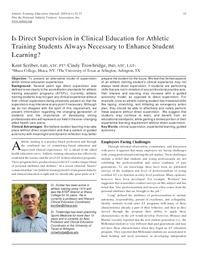
ATTENTION: The works hosted here are being migrated to a new repository that will consolidate resources, improve discoverability, and better show UTA's research impact on the global community. We will update authors as the migration progresses. Please see MavMatrix for more information.
Show simple item record
| dc.contributor.author | Scriber, Kent | |
| dc.contributor.author | Trowbridge, Cynthia | |
| dc.date.accessioned | 2016-11-18T23:57:58Z | |
| dc.date.available | 2016-11-18T23:57:58Z | |
| dc.date.issued | 2009 | |
| dc.identifier.citation | Published in the Athletic Training Education Journal 4(1): 32-37, 2009 | en_US |
| dc.identifier.issn | 1947-380X | |
| dc.identifier.uri | http://hdl.handle.net/10106/26273 | |
| dc.description.abstract | Objective: To present an alternative model of supervision
within clinical education experiences.
Background: Several years ago direct supervision was
defined more clearly in the accreditation standards for athletic
training education programs (ATEPs). Currently, athletic
training students may not gain any clinical experience without
their clinical supervisors being physically present so that the
supervisors may intervene at any point if necessary. Although
we do not disagree with the spirit of this requirement, we
present information regarding the changing generation of
students and the importance of developing strong
professionals who will represent our field in the ever-changing
allied health care arena.
Clinical Advantages: W e believe student learning may take
place without direct supervision and that a system of guided
autonomy with meaningful and dynamic reflection may better
prepare the student for the future. W e feel that limited aspects
of an athletic training student’s clinical experience may not
always need direct supervision. If students are performing
skills that are not in violation of any professional practice acts,
their interest and learning may increase with a guided
autonomy model, as opposed to direct supervision. For
example, once an athletic training student has mastered skills
like taping, stretching, and initiating an emergency action
plan, they should be able to effectively and safely perform
these aspects without direct supervision. W e suggest that
students may continue to learn, and benefit from an
educational standpoint, while gaining a limited portion of their
experiential learning requirement without direct supervision. | |
| dc.language.iso | en_US | en_US |
| dc.publisher | National Athletic Trainers’ Association, Inc. | en_US |
| dc.rights | Attribution-NonCommercial-NoDerivs 3.0 United States | * |
| dc.rights.uri | http://creativecommons.org/licenses/by-nc-nd/3.0/us/ | * |
| dc.subject | Clinical supervision | en_US |
| dc.subject | Experiential learning | en_US |
| dc.subject | Guided autonomy | en_US |
| dc.title | Is Direct Supervision in Clinical Education for Athletic Training Students Always Necessary to Enhance Student Learning? | en_US |
| dc.type | Article | en_US |
| dc.publisher.department | Department of Kinesiology, The University of Texas at Arlington | en_US |
| dc.identifier.externalLink | http://natajournals.org/doi/abs/10.4085/1947-380X-4.1.32 | en_US |
| dc.identifier.externalLinkDescription | The original publication is available at the journal homepage | en_US |
| dc.rights.license | Published under Creative Commons license, CC BY-NC-ND | |
Files in this item
- Name:
- 1947-380x-4.1.32.pdf
- Size:
- 85.12Kb
- Format:
- PDF
- Description:
- PDF
- Name:
- license_rdf
- Size:
- 1.203Kb
- Format:
- application/rdf+xml
This item appears in the following Collection(s)
Show simple item record
Except where otherwise noted, this item's license is described as Attribution-NonCommercial-NoDerivs 3.0 United States



